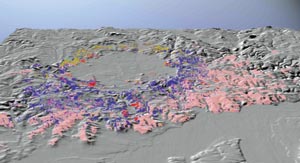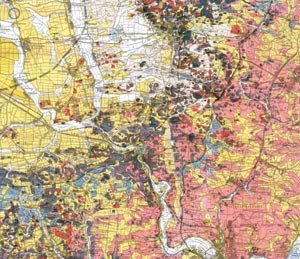GIS Helps Unravel the Earth's Development
Mapping an Ancient Meteorite Crater Gives Scientists Insight About Future Risks
Imagine plopping a pebble in the center of a small pond and watching the splashing water and the waves that ripple to the shoreline. Now, magnify that to gigantic  proportions and instead of a pebble make that a meteorite hurtling through outer space and splashing down on Earth. That gives you a picture of what happened some 15 million years ago in southern Germany.
proportions and instead of a pebble make that a meteorite hurtling through outer space and splashing down on Earth. That gives you a picture of what happened some 15 million years ago in southern Germany.
Right: A three-dimensional view over the Ries crater from south with the distribution of ejected masses. Digital terrain data courtesy of Bayerisches Landesvermessungsamt and Landsevermessungsamt Baden-Württemberg. View created with ArcView and Photoshop.
The Ries crater was formed when a meteorite about one kilometer in diameter struck the Bavarian landscape. One of the best preserved large impact structures in the world, the crater is about 25 kilometers in diameter and is accompanied by a smaller crater, the Steinheim Basin, about three kilometers in diameter. These two geological features represent the only two confirmed impact structures in Germany and have generated a lot of interest not only from within the geoscientific community but with anyone who is fascinated with the fused glass beads that were formed on impact and are found as far away as the Czech Republic.
Mapping the Crater
Scientists from many countries have been studying the craters for decades and not just because they are rock hounds. Impacts are a dominant geologic process in the formation of planetary bodies, and as rare finds, these intact impact structures are providing researchers with extensive geological, geophysical, and geochemical data for studying this phenomenon.
In 1973, the Bavarian Geological Survey began a research drill hole in the center of the crater with a final depth of 1,206 meters. Many of the modern concepts of impact  cratering and their structural significance have been tested at the Ries Crater according to Erwin Geiss, a geophysicist and GIS specialist with the survey.
cratering and their structural significance have been tested at the Ries Crater according to Erwin Geiss, a geophysicist and GIS specialist with the survey.
Left: The southeastern part of the crater (impact point is circle in the upper left corner).
GIS came to the project when work began on a revised geological map (1:50,000 scale) of the crater. The map was completely produced with Esri's ArcInfo and published not only as a paper map but also on CD-ROM as an ArcView and ArcExplorer project, which included outcropping descriptions, photographs, and topographic maps.
Explaining the significance of the mapping project, Geiss says, "The impacting body hit a very well-stratified target, which gave us a great advantage because we were able to determine the original depth and layer of the material that was thrown out during the impact. To get a better understanding of the impact process itself, I suggested using the digital map to do a geostatistical analysis of the age, size, and range of distribution of the ejecta."
What Does It All Mean?
Working with a well-known impact specialist, Dr. Jean Pohl from the University of Munich, and two other GIS specialists, Geiss used the GIS to help analyze the properties of the ejected masses. They looked at each material separately according to its geological unit before the impact and studied the combination of directional distribution of the ejecta and the height dependency (digital terrain model). "Much of these analyses are only possible with a digital map," says Geiss. "GIS helped us get a clearer picture of the chaos after the impact, and it also helped us communicate the results to others."
Along with the maps generated for the project, Geiss designed a poster, which won the first place most unique award at the 1999 Esri International User Conference in San Diego, California. The design is unusual and reflects the chaotic nature of the project. "We were working with something absolutely chaotic—an impact that within seconds completely turned around the tertiary landscape. I wanted to show that geology is not always static with changes over millions of years," he says.
Looking to the Future
Studying impact craters on Earth is helping Geiss and other researchers understand Earth's early development process. For instance, there is now evidence that links a large impact to a mass extinction event—the disappearance of dinosaurs. Some oil and gas reservoirs and mineral deposits are also related results of large-scale impacts.
Another reason for the importance of studying these structures is that it is enabling scientists to assess the risks of impacts. Large impact events, such as the fireballs portrayed in the movies Deep Impact and Armageddon, are readily recognized as hazards for the cataclysmic events they can cause. But on a smaller scale, there are other things to worry about than just blowing a hole in the atmosphere. Even relatively small impacts can bring about subtle but significant changes in the biosphere, terrestrial climate, and chemical atmosphere and cause tsunamis.
Geiss is convinced that there is a lot more to be learned, and he's not about to go back to studying paper maps. "Counting tiny colored patches on paper maps would be no fun at all," he says. His next step is to analyze remote sensing data of the crater taken from space. Satellite imagery provides an overall view in a large-scale context. In this vein, he intends to put ArcView 8.1 with the Geostatistical Analyst extension to good use.
Founded in 1850, the Bavarian Geological Survey is among the oldest institutions of its kind and is responsible for the collection, evaluation, and dissemination of geoscientific data for the State of Bavaria.
For more information, contact Erwin Geiss (e-mail: erwin.geiss@gla.bayern.de).
